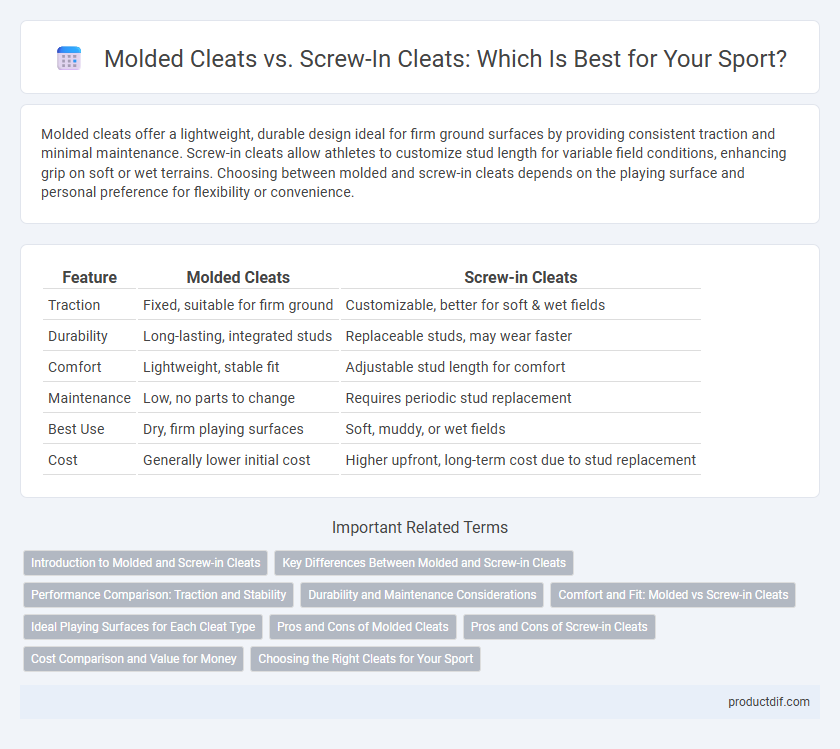Molded cleats offer a lightweight, durable design ideal for firm ground surfaces by providing consistent traction and minimal maintenance. Screw-in cleats allow athletes to customize stud length for variable field conditions, enhancing grip on soft or wet terrains. Choosing between molded and screw-in cleats depends on the playing surface and personal preference for flexibility or convenience.
Table of Comparison
| Feature | Molded Cleats | Screw-in Cleats |
|---|---|---|
| Traction | Fixed, suitable for firm ground | Customizable, better for soft & wet fields |
| Durability | Long-lasting, integrated studs | Replaceable studs, may wear faster |
| Comfort | Lightweight, stable fit | Adjustable stud length for comfort |
| Maintenance | Low, no parts to change | Requires periodic stud replacement |
| Best Use | Dry, firm playing surfaces | Soft, muddy, or wet fields |
| Cost | Generally lower initial cost | Higher upfront, long-term cost due to stud replacement |
Introduction to Molded and Screw-in Cleats
Molded cleats feature permanently attached rubber or plastic studs designed for durability and consistent traction on firm ground surfaces. Screw-in cleats, also known as detachable cleats, utilize metal or plastic studs that can be replaced based on playing conditions, offering customizable grip and enhanced performance on soft or muddy fields. Understanding the differences in design, traction, and maintenance helps athletes choose the most suitable cleats for their specific sporting needs.
Key Differences Between Molded and Screw-in Cleats
Molded cleats are permanently attached to the shoe with hard rubber or plastic studs, providing durability and consistent traction on firm surfaces. Screw-in cleats feature metal or interchangeable studs that can be customized for different field conditions, offering superior grip on soft or muddy terrain. The primary differences lie in their versatility, maintenance, and performance adaptability for various playing environments.
Performance Comparison: Traction and Stability
Molded cleats offer consistent traction and stability on firm, natural grass fields due to their fixed, evenly distributed studs that provide optimal ground contact. Screw-in cleats allow athletes to customize stud length for varying field conditions, delivering superior grip and enhanced stability on soft, muddy, or wet surfaces. Performance-wise, molded cleats excel in durability and quick directional changes, while screw-in cleats provide better adaptability and traction in diverse playing environments.
Durability and Maintenance Considerations
Molded cleats offer superior durability due to their one-piece construction, minimizing the risk of losing individual studs during play, which reduces maintenance needs. Screw-in cleats provide customizable traction by allowing players to replace worn or broken studs, but they require frequent inspection to prevent loosening and potential damage. Choosing between molded and screw-in cleats depends on the athlete's preference for low-maintenance footwear versus the ability to tailor grip and performance on varying field conditions.
Comfort and Fit: Molded vs Screw-in Cleats
Molded cleats offer a comfortable fit with their integrated design, providing consistent pressure distribution and a secure feel ideal for players prioritizing comfort during extended play. Screw-in cleats allow customization of stud length and placement, enhancing fit adaptability for varied field conditions but may require adjustment to avoid discomfort. Athletes often choose molded cleats for stability and low maintenance, while screw-in options suit those seeking personalized comfort and grip.
Ideal Playing Surfaces for Each Cleat Type
Molded cleats are best suited for firm, natural grass fields, providing stable traction without damaging the surface, ideal for dry or slightly damp conditions. Screw-in cleats excel on soft, wet, or muddy natural grass, offering adjustable stud length for deeper ground penetration and improved grip. Both cleat types are designed for natural terrain rather than artificial turf, where specialized turf shoes are recommended to prevent slippage and injury.
Pros and Cons of Molded Cleats
Molded cleats offer a lightweight design with permanent studs ideal for firm ground conditions, providing consistent traction and durability without the need for adjustment. They require less maintenance compared to screw-in cleats, as the studs are integrated into the sole, minimizing replacement costs and hassle. However, molded cleats lack customization for varying field types and may wear down faster on abrasive surfaces, reducing overall performance and lifespan.
Pros and Cons of Screw-in Cleats
Screw-in cleats offer superior traction and are easily replaceable, making them ideal for athletes who play on soft or wet fields. Their adjustable length provides better grip adaptability compared to molded cleats, reducing the risk of slipping during quick cuts. However, screw-in cleats require regular maintenance to prevent rust and can damage hard or artificial surfaces, limiting their versatility.
Cost Comparison and Value for Money
Molded cleats generally offer a lower upfront cost compared to screw-in cleats, making them a more budget-friendly option for casual players or those just starting out. Screw-in cleats, though more expensive initially, provide superior traction and durability, translating to better long-term value for athletes seeking enhanced performance and frequent play. Evaluating the cost versus benefits, screw-in cleats represent a worthwhile investment for serious players prioritizing lifespan and customization, while molded cleats serve as an economical choice for occasional use.
Choosing the Right Cleats for Your Sport
Molded cleats offer durability and stability for sports played on firm surfaces, making them ideal for football and baseball fields with synthetic turf or hard dirt. Screw-in cleats provide customizable traction and are preferred in slippery or muddy conditions common in soccer and softball, allowing athletes to adjust the stud length for optimal grip. Selecting the right cleats depends on the playing surface, sport-specific requirements, and personal comfort to enhance performance and reduce injury risk.
Molded cleats vs Screw-in cleats Infographic

 productdif.com
productdif.com